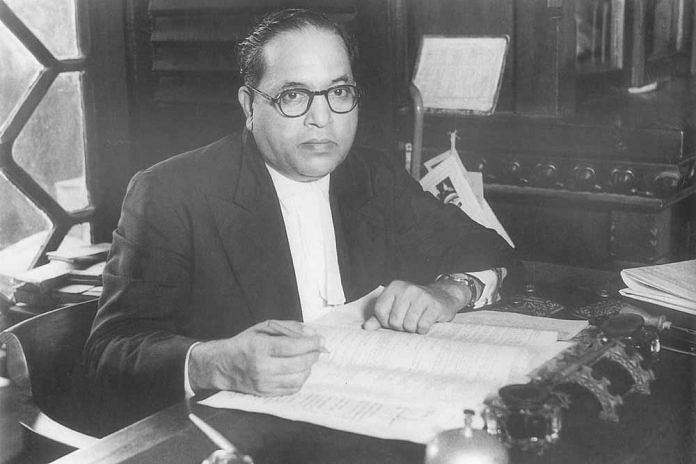Ambedkar was optimistic about constitutional democracy working in India. However, by 1953, he had lost hope.
ThePrint is publishing articles on Dalit issues as part of Dalit History Month.
In December last year, the BBC released rare footage of a 1953 interview it conducted with B.R. Ambedkar. The interviewer began with a simple yet profound question: “Dr Ambedkar do you think democracy is going to work in India?”
Ambedkar, without skipping a beat, replied: “No.”
Later on in the interview, he elaborated: ‘‘…Democracy will not work for the simple reason, we have got a social structure which is totally incompatible with parliamentary democracy…”
During the Constitution-making process, Ambedkar, on various occasions, warned members of the Constituent Assembly that “democracy in India is only a top-dressing on an Indian soil, which is essentially undemocratic…” But at the same time he was optimistic about constitutional democracy working in India.
However, by 1953, he had lost hope. What explains this?
Ambedkar’s disenchantment was caused by his experience with the Hindu Code Bill. The Bill, among other things, aimed to give more rights to women and undermined the role of caste in the sphere of personal laws. For Ambedkar, the principles of the Constitution could only be operationalised through programmatic steps that included social legislation — the Hindu Code Bill was one such attempt.
The Hindu Code Bill, which Ambedkar piloted along with Jawaharlal Nehru in the cockpit, was introduced in the Constituent Assembly in 1948 — it found support, especially from women members. However, the Bill triggered intense controversy and attempts were made to stall its passage. Opponents of the Bill argued that the Hindu religion was being attacked: Ramanarayan Singh, a noted freedom fighter and politician, felt that Ambedkar “now wants the Vedas [as] an offence, and this Bill should, in no case, be passed”. Conservative leaders of the Congress were also not pleased: Notable among them was Rajendra Prasad, who, in a letter, made it clear to Nehru that the progressive ideas of a few should not be imposed on the Hindu community.
There was resistance on the streets. Many right-wing organisations, including the RSS, came together and organised protests, public meetings, marches and burnt effigies of Ambedkar and Nehru. They believed that the Bill posed a danger to the Hindu religion and was an “atom bomb on Hindu society”.
Ambedkar was often singled out — and in bad taste: The highly influential Kalyan — a Hindu religious periodical in an article said of him: “…Himself of hinvarna (Dalit) who has married a Brahmin in old age and introduced the code Bill…” (Akshaya Mukul in Gita Press and the making of Hindu India).
In 1951, after the Consitution came into effect, the Constituent Assembly transformed into a provisional parliament. The Hindu Code Bill was again taken up for debate and opponents were determined to bury it: More than 100 amendments were moved. Ambedkar was getting increasingly frustrated, impatient and aggressive in the debates:
“Whatever else Hindu society may adopt, it will never give up its social structure for the enslavement of the Shudra and the enslavement of women. It is for this reason that law must now come to their rescue in order that society may move on.”
Critics of the Bill complained: “…We do not want these abuses and invective…”; “Why vilify the Hindu religion?”
The Assembly was headed towards an impasse.
Nehru was initially determined to ensure the passage of the Bill but, in the face of immense political opposition, especially from members of his own party, he buckled. The Bill was dropped. Ambedkar, who was law minister at the time, quit the Cabinet and the government. In his resignation letter, he was scathing:
“…The Hindu Code was the greatest social reform measure ever undertaken by the legislature in this country… To leave inequality between class and class, between sex and sex, which is the soul of Hindu society, untouched and to go on passing legislation relating to economic problems is to make a farce of our Constitution and to build a palace on a dung heap.”
Nehru, after arduous political jostling, piece by piece, eventually got the Bill passed in 1956. Ambedkar, however, was still reeling from his personal experience with the Bill; the episode had left him deeply pessimistic. Politics in India, he believed, would always be drenched with majoritarian and dominant class interests — stalling social reform and the realisation of constitutional values.
Contemporary political and social developments do indicate an erosion of the Indian Constitution. It is tempting to view this as a vindication of Ambedkar’s punditry. Instead, we could read Ambedkar’s scepticim more productively. We could use his critique of the Indian social structure to galvanise our efforts to reform it, view his observation that India lacked constitutional morality as an opportunity to create one, and see his loss of hope about constitutional democracy working in India as a challenge for us — the republic — to prove him wrong.
Vineeth Krishna E is lead associate editor for Constitutional and Civic Citizenship Project at the Centre for Law and Policy Research, Bengaluru. He primarily works on the CADIndia website — cadindia.clpr.org.in — a portal that facilitates public engagement with India’s rich constitutional and political history.
Read more from ThePrint’s Dalit History Month archives.






